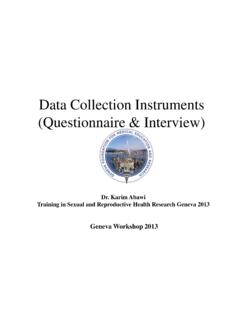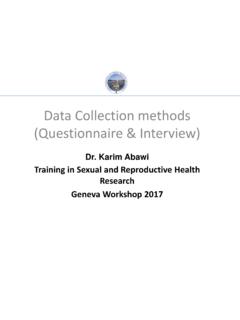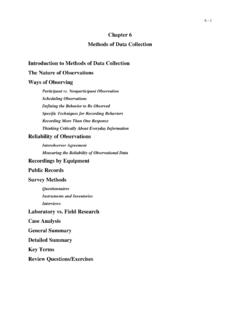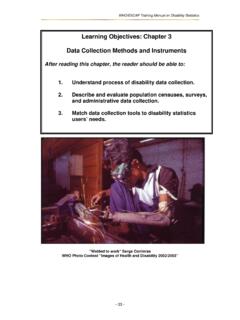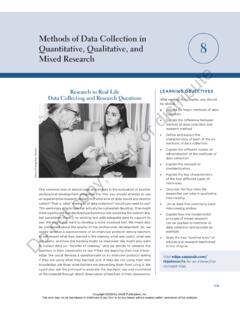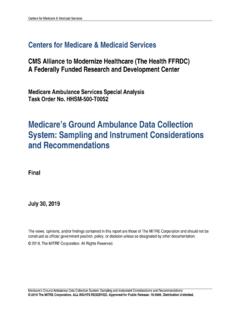Transcription of Data collection instruments - gfmer.ch
1 data collection instruments (Questionnaire & Interview) Dr. Karim Abawi Training in Sexual and Reproductive Health Research Geneva 2014 Geneva Workshop 2014 data collection instruments Accurate and systematic data collection is critical to conducting scientific research. data collection allows us to collect information that we want to collect about our study objects. Depending on research type, methods of data collection include: documents review, observation, questioning, measuring, or a combination of different methods.
2 Questionnaire A questionnaire is a data collection instrument consistent of a series of questions and other prompts for the purpose of gathering information from respondents. The questionnaire was invented by Sir Francis Galton. Questionnaire. Wikipedia: The Free Encyclopedia, September 2012. #References Steps required to design and administer a questionnaire 1. Defining the Objectives of the Study 2. Define the target respondents and methods to reach them. 3. Questionnaire Design 4. Pilot Testing 5. Questionnaire Administration 6.
3 Results Interpretation 1. Defining the Objectives of the Study A questionnaire should allow us to collect the most complete and accurate data in a logical flow. This is done in order to reach reliable conclusions from what we are planning to observe. A well-designed questionnaire should meet the research goal and objectives and minimize un-answered questions a common problem bound to many surveys. b. Define the target respondents and methods to reach them The researcher should clearly define the target, study populations from which she/ he collects data and information.
4 Main methods of reaching the respondents are: personal contact, group of focus interview, mail /Internet-based questionnaires, telephone interview. c. Writing the Questionnaire Before writing the questionnaire researcher should decide on the questionnaire content. Each question should contribute to testing one or more hypothesis/ research question established in the research design. Questions could be: Open format questions that are without a predetermined set of responses. Closed format questions that take the form of a multiple-choice question.
5 C. Writing the Questionnaire (Cont) Points to be considered when writing and interpreting questionnaires: Clarity (question has the same meaning for all respondents) Phrasing (short and simple sentences, only one piece of information at a time, avoid negatives if possible, ask precise questions, in line with respondent level of ) Sensitive question: avoid questions that could be embarrassing to respondents. Hypothetical Questions should be avoided if possible. d. Questionnaire pilot testing The major challenge in questionnaire design is to make it clear to all respondents.
6 In-order to identify and solve the confusing points, we need to pre-test the questionnaire. During the pilot trial: the questionnaire participants should be randomly selected from the study population. Conclusion Questionnaire design is a multi-step process. Questionnaires allow collection of both subjective and objective data in a large sample of the study population in order to obtain results that are statistically significant, specially when resources are limited. It is a good tool for the protection of the privacy of the participants.
7 The validity of data and information depends on the honesty of the respondent. The questionnaires can measure both qualitative and quantitative data , but is it more appropriate for quantitative data collection . 2. Interview Interviews consist of collecting data by asking questions. data can be collected by listening to individuals, recording, filming their responses, or a combination of methods. There are four types of interview: Structured interview Semi-structured interview In-depth interview, and Focused group discussion Structured interview In structured interviews the questions as well as their order is already scheduled.
8 Your additional intervention consists of giving more explanation to clarify your question (if needed), and to ask your respondent to provide more explanation if the answer they provide is vague (probing). Semi-structured and in-depth interviews Semi-structured interviews include a number of planned questions, but the interviewer has more freedom to modify the wording and order of questions. In-depth interview is less formal and the least structured, in which the wording and questions are not predetermined.
9 This type of interview is more appropriate to collect complex information with a higher proportion of opinion-based information. Advantages and disadvantages of interview Advantages: Collect complete information with greater understanding. It is more personal, as compared to questionnaires, allowing us to have higher response rates. It allows more control over the order and flow of questions. We can introduce necessary changes in the interview schedule based on initial results (which is not possible in the case of a questionnaire study/survey) Disadvantages: data analysis especially when there is a lot of qualitative data .
10 Interviewing can be tiresome for large numbers of participants. Risk of bias is high due to fatigue and to becoming too involved with interviewees.. 3. Focus group discussion Focus group is a structured discussion with the purpose of stimulating conversation around a specific topic. Focus group discussion is led by a facilitator who poses questions and the participants give their thoughts and opinions. Focus group discussion gives us the possibility to cross check one individual s opinion with other opinions gathered.
